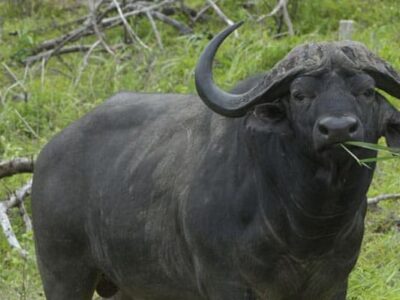The Big 5 African Animals, Pictures, Facts And Best Videos
Imagine traversing the vast savannas, your heart racing as you witness the raw beauty of nature’s most magnificent creatures. Introducing Africa’s Big Five: the lion, leopard, elephant, rhinoceros, and Cape buffalo. Once considered the most challenging and dangerous animals to hunt on foot, they now stand as iconic symbols of wildlife conservation and the allure of the African wilderness.
The term Big Five is not attributed to the animal’s size but focused on big game hunters that are more dangerous and difficult to hunt. These can be spotted in certain destination countries Like Uganda, Kenya, Tanzania, and Rwanda. Today we recommend seeing the Big Five – not shooting them during your once-in-a-lifetime Wildlife Safari in Africa.
The Big 5 Fun Facts
Face threats
Notable for physical strength
Central to African Culture
Native to African habitats
Respected by other animals
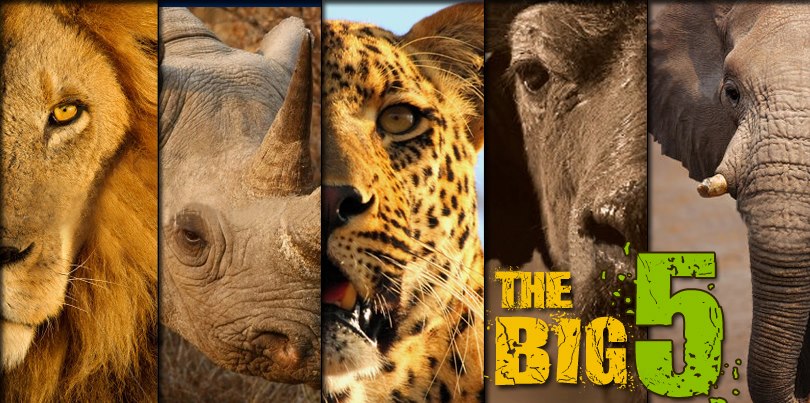
1. The African Lion
Often referred to as the “King of the Jungle” is part of the big 5, the lion is one of the most powerful creatures in the animal kingdom. The African lion is also thought to be the most social of all the big cats. The female lions are the hunters of the pride, their prey includes Wildebeest, Zebra, Giraffe, Buffalo, and young elephants. You can usually spot lions hanging around in open plains, where their ‘victims’ often congregate. They are best spotted on safaris in Queen Elizabeth National Park in Uganda and Kruger National Park as it is home to over 1600 of them! Note that you will be more likely to find them on the east side of the park.
Hunting and Diet:
Lions are formidable hunters, often working together to take down large prey such as zebras, wildebeest, and buffalo. Their cooperative hunting strategies, combined with their powerful bodies and sharp claws, make them highly efficient predators.
Habitat and Range:
African lions are predominantly found in sub-Saharan Africa, inhabiting grasslands, savannas, and open woodlands. They require large territories to support their prey and maintain their pride, with male lions often fiercely defending others from rivals.
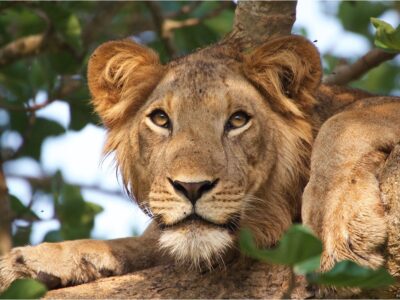
2. The Black Rhinoceros
The Black rhino can be best spotted in Namibia almost year-round its another composition of the big 5 animals. Simply go on a safari in Etosha National Park and you will find black rhinos roaming the park’s Okaukuejo watering hole! Ziwa Rhino and Wildlife Ranch is the home of the only white rhinos in Uganda. Except for females and their offspring, the Black Rhinos are solitary creatures – preferring to live alone. They feed at night as well as during dawn and dusk. Their sustenance mainly comes from leaves and fruits found in trees and bushes. You’d also be interested to know that rhinos have poor vision, they make it up with an excellent sense of smell and hearing.
Behavior and Diet:
Black rhinos are primarily browsers, feeding on a variety of vegetation, including leaves, branches, and fruit. They are generally solitary animals, with each individual maintaining a large territory. Despite their size and strength, black rhinos are known for their shy and reclusive nature, often avoiding human contact whenever possible.
Habitat and Range:
Once widespread across Africa, black rhinos are now found in scattered populations, primarily in protected reserves and national parks in eastern and southern Africa. They thrive in diverse habitats, from arid deserts to dense forests, where they play a vital role in shaping the landscape by controlling vegetation growth.
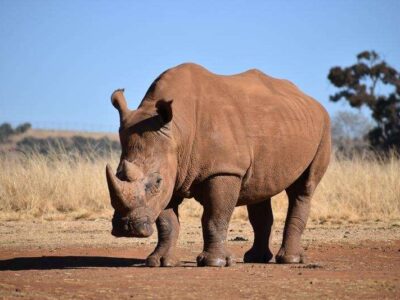
3. The African Elephant
The largest land animal in the world, they can be found in over 36 different countries in Africa. There are 2 different species of the African elephant: the savannah elephant and the forest elephant. Elephants can be spotted in Uganda – Queen Elizabeth National Park. The forest elephant is usually smaller with rounded ears as well as tusks that grow downward. While the Savannah elephants can be found in the savannah of Africa, the forest elephants inhabit the rain forests of Central and Western Africa. Highly social animals, they are known to be able to communicate with others across large distances at a low frequency which can not be heard by humans.
Intelligence and Social Structure:
Elephants are renowned for their intelligence, often compared to that of primates and cetaceans. They exhibit complex social behaviors, living in matriarchal herds where older females lead and pass down knowledge to younger generations. Elephants are known for their strong familial bonds, mourning their dead, and showing empathy towards others.
Ecological Role:
African elephants are considered a keystone species due to their significant impact on their environment. As “ecosystem engineers,” they shape their habitats by uprooting trees, creating waterholes, and dispersing seeds through their dung. Their activities help maintain the biodiversity of the savannas and forests they inhabit, benefiting countless other species.
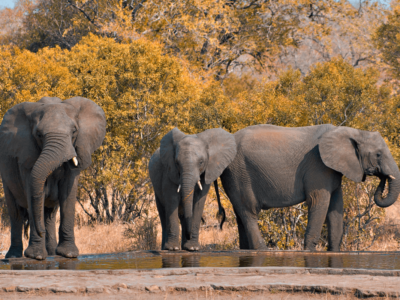
4. The African Leopard
The South Luangwa Park in Zambia is one of the few parks that operate a night safari, and since leopards are nocturnal creatures, the possibility of you finding them increases! African leopards have a preference for rocky landscapes with dense bush and riverine forests and are also excellent at swimming. Excellent climbers, the leopard’s spotted coat provides almost perfect camouflage which comes in handy when they hunt. A stealthy hunter, once they catch their prey, they’ll often safeguard it by taking it up to the trees to prevent other animals such as lions or hyenas from stealing their food.
Physical Characteristics:
Leopards are smaller than lions and tigers, but their muscular build and powerful limbs make them formidable hunters. Their distinctive rosette-patterned coat provides perfect camouflage in the dappled light of forests and savannas. This beauty, however, makes them targets for illegal wildlife trade, where their skins are highly prized.
Behavior and Hunting Techniques:
Unlike many other big cats, leopards are solitary animals, coming together only to mate or when a mother is raising her cubs. They are highly opportunistic hunters, with a diet ranging from small birds to large antelope. Leopards are also known for their strength, often dragging prey much heavier than themselves into trees to protect it from scavengers.
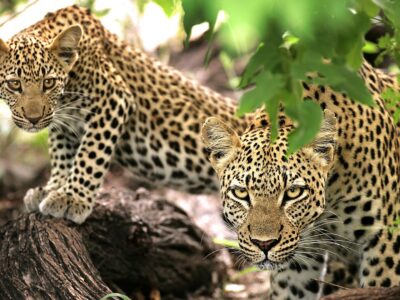
5. The Cape Buffalo
The best place to spot the buffalo is actually on safaris in Kidepo Valley National Park, Uganda where up to 4,000 individuals gather at once making it a lifetime experience. Often hunted by the lion, they are extremely loyal to their herd and would often try to rescue another member if they are caught by a predator. The Cape buffalo is not closely related to the water buffalo (commonly found in Asia) though they do look somewhat similar to each other. Unlike the water buffalo, they are quite dangerous and have never been known to be domesticated.
Impressive Physicality:
The African Buffalo is a powerhouse, weighing up to 2,000 pounds and standing nearly 6 feet tall at the shoulder. Its massive, curved horns are not just for show; they are powerful weapons used to defend against predators, including lions. The buffalo’s thick, muscular body and strong legs make it a formidable force, capable of charging at speeds of up to 35 miles per hour.
Social Structure and Behavior:
Buffaloes are highly social animals, typically living in large herds that can number in the hundreds. These herds are tightly knit, with individuals displaying strong bonds and collective defense mechanisms. When threatened, buffaloes are known to form a protective circle around their young and injured, showcasing their remarkable group cohesion and defensive strategies.
